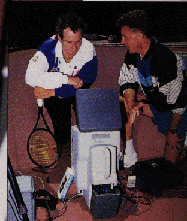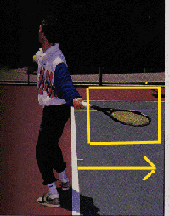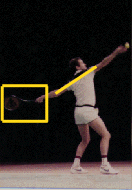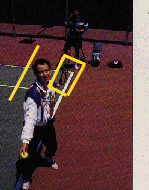Visual Tennis, Part 2:
The McEnroe Case Study
By John Yandell
Go to Part 1 of the
Visual Tennis Series on TennisONE
In the middle of 1991, John McEnroe was in the middle of a serious comeback. He was
convinced he could still compete with the world's top players. But he had a problem.
For a period of several months his serve--the dominating shot that had made him one of the
most electrifying players in tennis history during the late 1970's and early 1980's--was
consistently the weak link in his play. His first serve percentage was averaging less than
50%. Meanwhile the radar gun was registering ball speeds in the mid 90 mph range.
The result was that John had to work very hard on his service games, was under constant
pressure to hit difficult first volleys, and was often broken twice or three times a set.
Though his legendary mental toughness kept him in many matches, he seemed to have lost the
firepower to win against top players. Many observers commented that at age 30 the game had
passed him by.
 Working with John in making the "Winning Edge"
instructional video in 1984, I had spent hundreds of hours studying his technique,
particularly on his serve. Watching John play in 1990, however, it was clear to me
that he had developed a severe technical problem his backswing that was the direct cause
of his loss of consistency and power. When I saw John in San Francisco, he agreed
to let me analyze the changes in his motion and compare it to the glory days of the
mid-1980's. We both believed that if he could recover the biomechanics of his motion, he
could restore his serving effectiveness and compete successfully again at the highest
levels of the game.
Working with John in making the "Winning Edge"
instructional video in 1984, I had spent hundreds of hours studying his technique,
particularly on his serve. Watching John play in 1990, however, it was clear to me
that he had developed a severe technical problem his backswing that was the direct cause
of his loss of consistency and power. When I saw John in San Francisco, he agreed
to let me analyze the changes in his motion and compare it to the glory days of the
mid-1980's. We both believed that if he could recover the biomechanics of his motion, he
could restore his serving effectiveness and compete successfully again at the highest
levels of the game.
Few coaches in any sport ever get the chance to measure the effectiveness of their work on
world class athletes. Even though I had been on court with John extensively during the
filming of "The Winning Edge," this was a different situation. I had worked with
highly ranked players before, including lower level tour players and nationally ranked
juniors. But this was the chance to use the visual tennis methodology with a legendary
champion.
When John and I began working together in February 1991, the approach I took was exactly
the same as with the hundreds of players at all levels who had come to the tennis school
with technical problems.
The first step is always identifying the problem, and more importantly, identifying
it for the player in a medium he can truly understand. To accomplish this, high
speed video analysis is critical. Because the natural learning process is visual, the
verbal descriptions that are typical of tennis lessons--"you're not turning,"
"your contact is late," etc., are usually ineffective.
In John's case, the problem was a shift in the shape of his backswing. Although his
sideways stance and increased torso rotation it generated were an advance in the
biomechanics of serving, the rest of John's service motion was completely and perfectly
classic.
His shoulders and hips were almost parallel to the baseline at the start of the
motion, but his arm and racquet path stayed in the plane of his shoulders during the
windup. For the average player this would mean the arm and racquet would drop down
and then point straight back at the back fence.
For John with his sideways stance, it meant that as the arm and racquet moved through the
wind up in the plane of the shoulders, they were actually parallel to the baseline
until coming up at the start of the racquet drop. This was the fluid, effortless motion
that I knew so well from the "Winning Edge."
Many commentators believe that at his peak, John McEnroe's serve was the best in the
history of tennis. Because of his unique starting stance, McEnroe was able to take the
biomechanics of serving to a new level. As the motion begins, his torso and back are
literally turned to the net. As his racquet moves to the ball, this creates 180 degrees of
hip and shoulder rotation, roughly double that of other top servers who use a traditional
starting stance with the shoulders and hips perpendicular to the net.

Frame by frame analysis later showed that this change was putting a third to a half second
delay in his motion, compared to the timing of his serve in "The Winning Edge."
From this extremely awkward position, John was forced to muscle the racquet forward to
continue the motion, causing an obvious loss of rhythm and momentum, as well as putting
pressure on the shoulder joint.
The first step was to show John exactly what had happened. Rather than go into the verbal
description of the changes in the technical shape of the motion, I had him warm up, then
hit serves while I filmed him using our portable high speed video system.
Although John was well aware that something was seriously wrong in his motion, he had
literally no idea what had happened to his backswing. When I showed him the slow motion
replay, it was the only time I've ever seen him at a loss for words.

Still on court using the video system, we looked at examples of his service motion from
"The Winning Edge" that showed the backswing moving freely with the arm and
racquet in the plane of the shoulders and parallel to the baseline. We focused on one key
still frame, with the arm and racquet in line with the shoulders, parallel to the
baseline, and the racquet face square, or perpendicular to the court surface.
Now I had John stand in position to serve and move through his wind up in slow motion
until he reached the key position we had just identified. I had him close his eyes
and make an internal kinetic image, in other words, visualize exactly what this position
looked like and felt like inside his mind. I told him to project that mental image
into space behind him like an imaginary template or blueprint and simply move his arm and
racquet should move through this model image we had created.
John understood perfectly. I stepped back, held my breathe and watched. The first serve he
hit, half of the deviation in the backswing disappeared. That was exciting--and at
that moment I knew that the visual tennis process was going to work for John.


After a total of about 4 hours on the court--alternating between practice serves,
playing points and video analysis, the deviation in his motion was almost completely gone.
The windup stayed parallel to the baseline with the racquet face perpendicular. The ball
was coming off his racquet with a more solid and forceful sound. The result was an
increase of 10-15 mph in service velocity during our work.
We went a bit further and tweaked his knee bend, increasing it slightly, again, to conform
to the model images from "The Winning Edge."
The real test came that March in Chicago when John played his first tournament since the
training. The results were as good as I could possibly have hoped.
The motion held together beautifully. For the tournament John served 60%, with his
serves consistently registering in the 108 mph--115 mph range. In the final he
served 15 aces and defeated his brother Patrick to win the event. I knew for sure that
John was making the process work for him when I saw him step back and model the key
backswing position at a key point in the final match.
A month later I went to Malibu and we repeated the 2-day training process. But there was
little for me to do besides video John, exchange banter, and enjoy watching him workout
with Patrick on the clay courts at the Riviera Country Club. Every time we checked the
serve it was conforming beautifully to the model.
Later that year when John hired Larry Stefanki as his full time coach, I made Larry a tape
showing the key images of "The Winning Edge," plus the before and after video of
our work. They continued to use the tape to keep the serve on line.
It was fabulous to see John's run to a last semi-final at Wimbledon in 1992, where he lost
to eventual champion Andre Agassi, and then to the quarterfinal of the U. S. Open later
that year. John graciously acknowledged the role of our work in his comeback, and this was
picked up in the television coverage, as well as in an article I did for "World
Tennis."
From my own experience, I had always believed that the visual tennis training process
would work at any level of the game. Now I was certain. Next Part of the Visual Tennis
series of articles on TennisONE: more on how you can make it work for yourself.
End of Part 2
Go to Part 1 of the Visual Tennis Series on TennisONE
Last Updated 9/1/98. To contact us, please email to: webmaster@tennisone.com
TennisONE is a registered trademark of TennisONE and SportsWeb ONE; Copyright 1995. All rights reserved.
